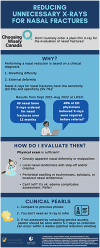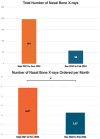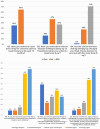Reducing Unnecessary X-Rays for Nasal Fractures: A Quality Improvement Project
- PMID: 40391622
- PMCID: PMC12093000
- DOI: 10.1177/19160216251336681
Reducing Unnecessary X-Rays for Nasal Fractures: A Quality Improvement Project
Abstract
BackgroundChoosing Wisely Canada recommends against the use of nasal bone X-rays for the evaluation of nasal fractures. The goal of this quality improvement project was to reduce the number of nasal bone X-rays ordered at our institution by 50% by 1 year.MethodsThe Institute for Healthcare Improvement Model for Improvement was used, and a pre- and post-intervention study was conducted. Change ideas included the following: a clinical decision support tool, provider surveys, and education. The number of X-rays ordered monthly was monitored. Financial cost (labor, materials, and overhead) was assessed. Environmental impact was extrapolated based on carbon dioxide equivalent emissions (CO2e). Balancing measures included the use of computed tomography (CT) scans. Analysis included summary statistics, statistical process control charting, and unpaired t-tests.ResultsThere was a 73% reduction in total X-rays ordered from 197 pre-intervention (September 2021-November 2022) to 58 post-intervention (December 2022-February 2024). There was a statistically-significant decrease in difference of means of 2.6 X-rays/month (4.9 vs 2.3, pre vs post; P < .001), an average monthly reduction of 53%. There was special cause variation after implementation. Cost savings was $5534.98, and environmental footprint reduction was 111.2 kg of CO2e. There was no compensatory increase in the number of CT scans ordered.ConclusionImplementation of a clinical decision support tool and education resulted in a significant reduction in the number of nasal bone X-rays ordered for the evaluation of nasal fractures. This Choosing Wisely Canada project ultimately reduces unnecessary investigations for patients, saves health care costs, and reduces environmental impact.
Keywords: choosing wisely medical education; clinical practice guidelines; clinical research; comprehensive otolaryngology; evidence-based medicine; health policy; quality improvement.
Conflict of interest statement
Declaration of Conflicting InterestsThe author(s) declared no potential conflicts of interest with respect to the research, authorship, and/or publication of this article.
Figures











Similar articles
-
A national intervention to reduce imaging for low back pain by general practitioners: a retrospective economic program evaluation using Medicare Benefits Schedule data.BMC Health Serv Res. 2019 Dec 21;19(1):983. doi: 10.1186/s12913-019-4773-y. BMC Health Serv Res. 2019. PMID: 31864352 Free PMC article.
-
Nasal bone fractures and the use of radiographic imaging: An otolaryngologist perspective.Am J Otolaryngol. 2019 Nov-Dec;40(6):102295. doi: 10.1016/j.amjoto.2019.102295. Epub 2019 Sep 9. Am J Otolaryngol. 2019. PMID: 31526629
-
Choosing Wisely Canada rhinology recommendations.J Otolaryngol Head Neck Surg. 2020 Feb 28;49(1):10. doi: 10.1186/s40463-020-00406-9. J Otolaryngol Head Neck Surg. 2020. PMID: 32111259 Free PMC article. Review.
-
[A method for obtaining x-rays of the bones of the nose for the diagnosis of fractures].Sud Med Ekspert. 1993 Apr-Jun;36(2):37-8. Sud Med Ekspert. 1993. PMID: 7940634 Russian.
-
Is Surgical Navigation Useful During Closed Reduction of Nasal Bone Fractures?J Craniofac Surg. 2017 May;28(3):e208-e210. doi: 10.1097/SCS.0000000000003564. J Craniofac Surg. 2017. PMID: 28468188 Review.
References
MeSH terms
LinkOut - more resources
Full Text Sources
Medical

